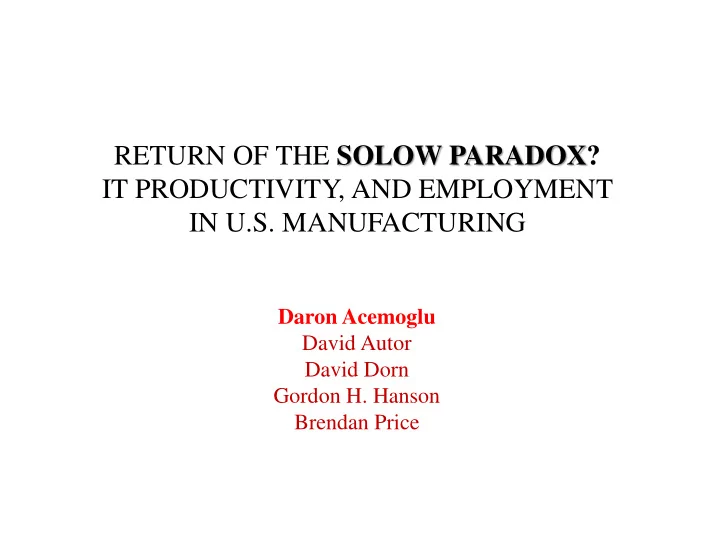

RETURN OF THE SOLOW PARADOX? IT PRODUCTIVITY, AND EMPLOYMENT IN U.S. MANUFACTURING Daron Acemoglu David Autor David Dorn Gordon H. Hanson Brendan Price
summary • An increasingly influential “ technological-discontinuity ” paradigm suggests that IT-induced technological changes are rapidly raising productivity while making workers redundant. • This paper explores the evidence for this view among the IT- using U.S. manufacturing industries. There is some limited support for more rapid productivity growth in IT-intensive industries depending on the exact measures, though not since the late 1990s. • Most challenging to this paradigm, and our expectations, is that output contracts in IT-intensive industries relative to the rest of manufacturing. Productivity increases, when detectable, result from the even faster declines in employment.
Productivity Paradox • The productivity paradox was analyzed and popularized in a widely cited articles by Erik Brynjolfsson (1993,2011), which noted the apparent contradiction between the remarkable advances in computer power and the relatively slow growth of productivity at the level of the whole economy, individual firms and many specific applications. The concept is sometimes referred to as the Solow computer paradox in reference to Robert Solow's 1987 article: • ““what everyone feels to have been a technological revolution, a drastic change in our productive lives, has been accompanied everywhere, including Japan, by a slowing-down of productivity growth, not by a step up. You can see the computer age everywhere but in the productivity statistics””
Technological Discontinuity • A technological discontinuity (TD) is a novel and paradigm- inconsistent concept of creating and capturing value in a given industry. – digital imaging (relative to film-based imaging), – online news (relative to printed news), – low-cost airlines (relative to flag carriers), – quartz watches (relative to analog watches) – Voice over Internet Protocol (relative to traditional landline telecommunication) As exemplified by the stumbling of Polaroid and Kodak incumbent firms in the photographic industry that lost their market dominance to new entrants whose businesses were based on digital imaging. TDs can engender drastic shifts in market structures .
Introduction • U.S. workplaces have been, and will continue to be, automated and transformed by information technology (IT) capital. Two implications of this transformation are emphasized. • First, all sectors but particularly IT-intensive sectors are experiencing major increases in productivity . Thus, Solow’s paradox is long since resolved: computers are now everywhere in our productivity statistics. • Second, IT-powered machines will increasingly replace workers , ultimately leading to a substantially smaller role for labor in the workplace of the future
Information Technology and Labor Productivity • where Y is an outcome variable (expressed in log points) the log of real shipments per worker, TFP, nominal value added, and the wage bills paid to non-production and production workers. • IT is a static measure of industry IT-intensity rates of computer investment ( industry’s raw computer investment rate as 100 times the ratio of its computer expenditures to its total capital expenditures). Usage of a set of manufacturing technologies (surveys of Manufacturing Technology (SMT) which queries manufacturing plants on their usage of 17 advanced manufacturing technologies.).
Correlation Between IT Measures
Information Technology and Labor Productivity • This productivity growth pattern is unexpected in light of the earlier resolution of the Solow Paradox (e.g., Oliner and Sichel, 2000).(two points)
Information Technology and Labor Productivity
Information Technology and Labor Productivity
Information Technology and Labor Productivity • however, the relationship between SMT IT-Intensity measure and industry-level labor productivity plateaus in the late 1990s, and shows little further relative gain in labor productivity after 1999. • In sum , our evidence so far suggests very limited IT driven productivity growth in computer intensive manufacturing industries, with the contrasting result of more rapid productivity growth in industries using advanced manufacturing technologies more intensively.
What Drives Rising Y/L — The Numerator or the Denominator? • Under the assumption that IT-intensive industries are seeing improvements in technology and automation and reductions in production costs, we would expect them to experience a relative
What Drives Rising Y/L — The Numerator or the Denominator? • The combination of rising log output per worker and falling log output in IT-intensive industries implies that log employment must have fallen even more rapidly than output in these industries, a reality confirmed by Figure 3.
relationship between IT and skill intensity.
Results using Changes in the Rate of Computer Investment • As a final exercise, Table A.4 addresses the possibility that changes in the rate of computer investment may be more predictive of productivity growth and output growth than the levels of this rate.
Conclusion This paper documents a pattern of growth among IT-using manufacturing industries that stands in contrast to the powerful and intuitively appealing view that IT is making workers redundant through outsized productivity gains. While we find some evidence of differential productivity growth in IT intensive manufacturing industries, this depends on the measure of IT intensity and is never visible after the late 1990s . More importantly, when present, it is driven by declining relative output accompanied by even more rapid declines in employment
Conclusion It may well be that IT-induced technological changes are transforming non-manufacturing, or that they are so widespread as to be taking place rapidly even in non-IT-intensive industries. But at the very least, our evidence suggests that the previously proposed resolutions of the Solow Paradox need to be critically examined, and that proponents of the technological-discontinuity view need to provide more direct evidence of the IT-induced transformation in the U.S. economy.
Recommend
More recommend